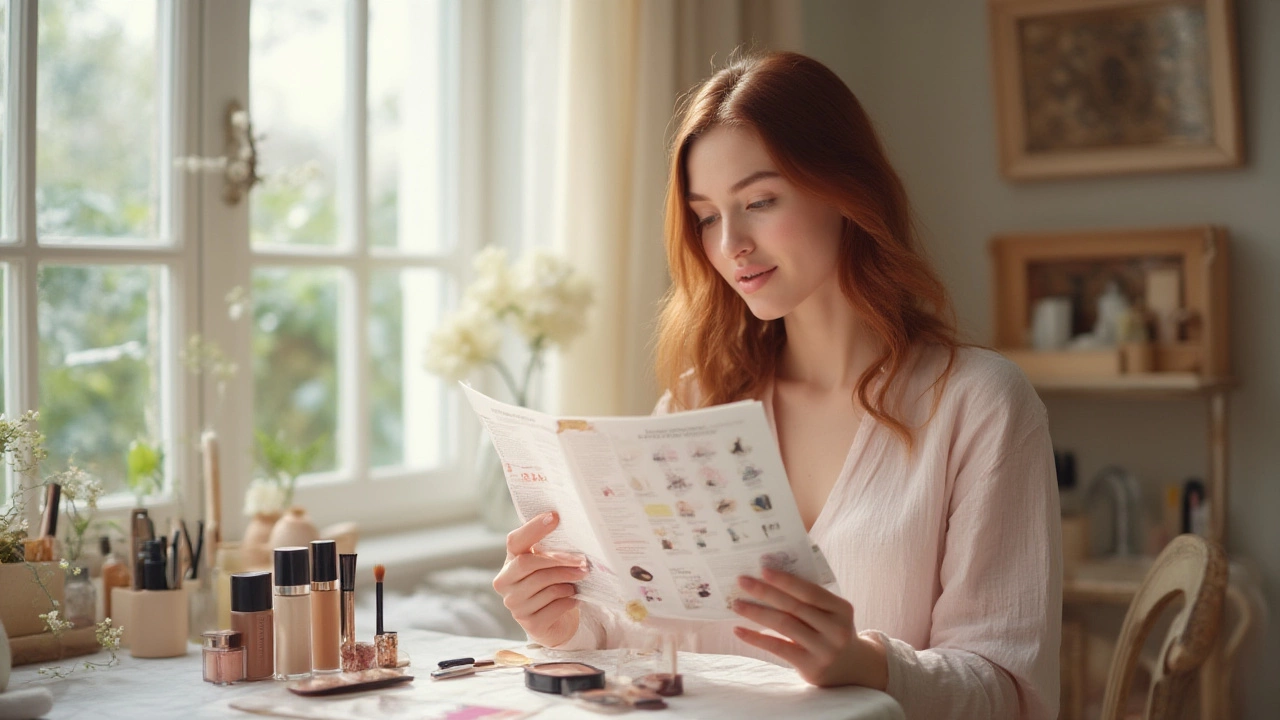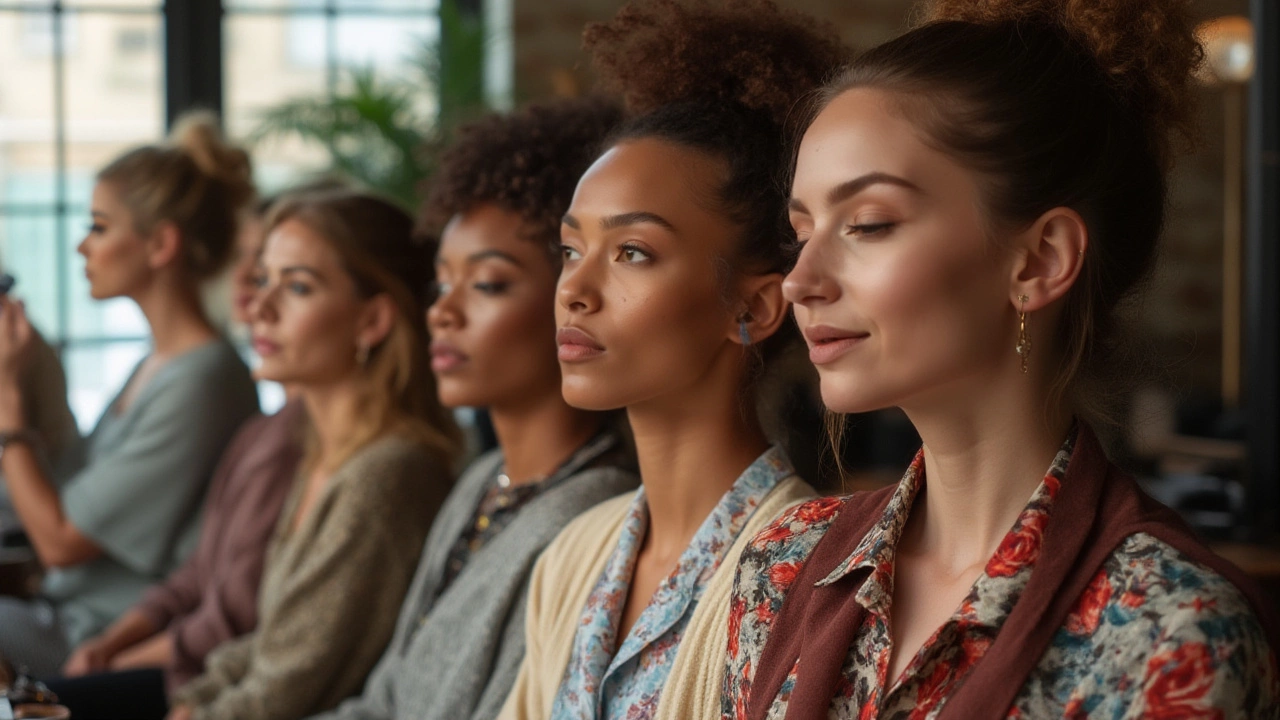
Ever stared at your makeup bag and wondered if you've been layering things in the wrong order your whole life? You’re not alone. Tons of people—even beauty fanatics—get tripped up by which product comes next. Get one step wrong, and suddenly, your concealer creases or your foundation pills. Nailing down the correct order isn’t just about tradition, it's all about getting that smooth, natural finish and keeping your look locked in all day. There are actually some pretty good science-backed reasons for this order—and a few sneaky tricks that can take your routine to the next level. Let’s talk about the real, practical order of makeup without any of that old-school confusion.
Why Does the Makeup Order Matter?
There's a method to the madness. Each product is designed to do its job on either bare skin, other products, or as a final touch. Skipping around can mess with how products blend, set, and stay. For example, slapping powder on before liquid foundation? Huge mistake. It’ll cake up and ruin your base. Ever noticed how sunscreen, moisturizer, and primers go on before makeup? That isn’t just habit; it actually affects absorption and texture. Think of your face like a canvas. Acrylic paint needs primer; so does your skin. If you skip straight to makeup without prepping, you risk irritation or patchiness. Research from the International Journal of Cosmetic Science (2023) even confirmed that layering skincare and primer first can improve how foundation sits and wears for up to 8 hours longer.
The order also makes a difference if you want your makeup to last. Applying powder products onto wet layers can cause streaks. Creams blend into creams, and powders lock everything down. It’s about science—oils repel water, so an oil-based primer over water-based moisturizer is a disaster waiting to happen. Even something simple like waiting a minute between sunscreen and makeup isn't just an Instagram tip; your skin really does need a moment to drink it in. That’s why makeup artists on movie sets spend so long doing skin prep—they want the base to last through hot lights and long hours, and it works the same for every day, not just the red carpet.
So, what’s the damage if you mix things up accidentally? Well, foundation can look uneven, blush may streak, and eyeshadow refuses to blend. Even makeup removers work in a certain order for a reason. One stat: 63% of people who apply makeup out of order have more complaints about caking, fading, and creasing, according to a 2024 Allure survey of makeup wearers in New Zealand and Australia. Those little annoyances? Often, they have nothing to do with your products and everything to do with your routine.
So why memorize this order, anyway? Save time, save money, and get results you love. Your makeup will blend more smoothly, last longer, and look far more natural. Plus, you’ll whiz through your morning routine without playing a guessing game. Whether you’re just starting out or looking to upgrade your skills, getting the order right is the most game-changing thing you can do for your beauty routine.
The Correct Order of Makeup Products—Step by Step
Alright, let’s get into the nitty-gritty: the correct order. Forget those silly TikTok trends. Here’s how the actual experts, like Lisa Eldridge and Bobbi Brown, have been doing it for decades. And yes, it works for glam, everyday, or natural makeup—just swap out products as you like.
- Skincare Prep: Cleanser, toner, moisturizer. Never rush this step—hydrated skin means everything goes on smoother. Wait a minute between layers if you can. If you wear SPF during the day—and you should—apply it after moisturizer and let it absorb for a few minutes.
- Primer: This creates an even base and helps makeup grip better. Choose one that matches your needs: mattifying for oil, hydrating for dry skin, blurring for visible pores. Don’t overdo it; a pea-sized amount is enough.
- Foundation: Liquid, cream, or powder—whatever suits you. Dab and blend outwards. Use less on areas that crease (like under eyes).
- Concealer: Apply after foundation to target specific areas like under eyes, blemishes, and redness. Tap gently, don’t rub.
- Cream Products (Blush, Bronzer, Highlight): These go on beautifully over liquid or cream foundation. Blend while your base is still a bit tacky for the most natural look.
- Setting Powder: Focus on areas that get oily—often the T-zone (forehead, nose, chin). Skip this if you’re loving the dewy look.
- Powder Products (Blush, Bronzer, Highlight): Layer these after setting to lock in color. If you want extra pop, use both cream and powder versions; just keep the order right.
- Brows: Pencil, pomade, powder—whatever you vibe with. Brush them up first, then fill in sparse bits.
- Eyeshadow: Start with primer if you want it to last, then lay down transition shades, deeper colors, and shimmer.
- Eyeliner: Creams and gels before powder shadow can smudge, so usually after shadow works best.
- Mascara: Always do this after shadow and liner—you do not want shadow fallout sticking to mascara.
- Lips: Balm, then liner (if using), followed by lipstick or gloss. For more staying power, blot and add a second layer.
- Setting Spray: The final lock. Keeps everything in place, especially on humid or sweaty days.
Here’s a handy table you might want to screenshot:
| Step | Product | Tip |
|---|---|---|
| 1 | Skincare & SPF | Hydration sets the canvas |
| 2 | Primer | Blurs texture, grips makeup |
| 3 | Foundation | Start from center, blend out |
| 4 | Concealer | Target only where needed |
| 5 | Cream Blush/Bronzer | Use fingers for natural blend |
| 6 | Setting Powder | Press with a puff, don’t rub |
| 7 | Powder Blush/Bronzer | Swirl lightly, build color |
| 8 | Brows | Brush up for fullness |
| 9 | Eyeshadow | Light to dark, inner to outer |
| 10 | Eyeliner | Go thin for day, bold for night |
| 11 | Mascara | Wiggle from root to tip |
| 12 | Lips | Match undertones to blush |
| 13 | Setting Spray | Hold 20cm away, mist lightly |
This order isn’t just a random rule. It solves a lot of makeup whodunit mysteries. Why does your blush streak? Probably applying powder after creams. Why does foundation look dry? Maybe you skipped moisturizer or didn’t wait for products to absorb. Following this lineup fixes these issues instantly.

When It’s Okay to Bend the Rules
You might be thinking, "Sure, but does everyone really have to follow this?" Yes, but also, not always. Hear me out. There are times when the rulebook can be tossed—like when you're experimenting, in a rush, or have a specific look in mind. Ever hear of 'reverse makeup'? That’s where some pro artists start with eye makeup before doing face makeup—handy if you’re prone to shadow fallout or creating a dramatic eye. That way, you can clean up under the eyes with a swipe of concealer after you’re done.
Or maybe you see someone mixing skincare with foundation or using liquid highlighter before foundation for a 'glow from within.' That works for some textures or specific looks and can actually look amazing on camera. There are even makeup artists who skip primer altogether if the skin is prepped perfectly with skincare. It’s all about knowing the standard so you can play around on purpose—not by accident.
Got dry skin? Cream products can be layered more liberally, and you might barely use powder at all. Oily skin? You might powder twice—before and after foundation, as suggested in the viral 2024 'Jello Skin' routine (which actually does hold up in Auckland heatwaves). For people with deep complexions, some color correct before foundation—usually with orange or red-tinted primers to neutralise darkness around the mouth or under eyes. That might seem like an extra step, but it makes a huge difference in how foundation shows up.
So yeah, the order is there for a reason—but true makeup lovers know when to break the rules. Don’t feel chained to any step, but know how it’s supposed to work. When you have that locked down, you can tweak, shift, and skip until it suits you perfectly. Just don’t go wild mixing powders and creams; even TikTok can’t save you if you go down that road.
"Layering products in the right sequence ensures each formula performs as intended, giving you longer wear and a more natural look." — Lisa Eldridge, celebrity makeup artist
Tips and Hidden Gems for Each Step
The right order is only the start—let’s dig into the small tweaks that can upgrade your routine from "just okay" to "total pro." Ever notice that some people’s makeup looks flawless up close? Usually, they know these tricks. Here are practical, tried-and-tested tips for every step, borrowed from both international pros and my own Auckland circle of makeup junkies:
- Skincare: Always wait 60 seconds between layers. Your skin will thank you with smoother, less streaky foundation.
- Primer: Don’t use silicone primer if you’re following up with a water-based foundation. Check ingredients! Mixing textures leads to pilling (those little balls that rub off as you blend).
- Foundation: Use a damp sponge for a natural, skin-like finish or a dense brush for full coverage. Always blend downward to avoid disturbing any fine hairs (peach fuzz) on your face.
- Concealer: Pick a shade one tone lighter than your foundation for brightening under the eyes, and one that matches for covering spots.
- Cream Products: Warm up on your hands first so they glide on easier. Use your fingers to melt the formula into your skin, especially if you want that fresh-faced, no-makeup look.
- Powder: Less is more. Use a small fluffy brush for precision—don’t just slap it everywhere. And always dust off excess—even setting powder should settle lightly, not pile up.
- Brows: Use a spoolie (the brush at the end of a brow pencil) to diffuse harsh lines. Light, feathery strokes mimic actual hairs.
- Eyeshadow: Start with a light matte shade as your 'base' and save shimmer for your lids or the inner corner. Want more color? Spray your brush lightly with setting spray before picking up shimmer.
- Mascara: Zigzag the wand as you pull through. Don’t forget the bottom lashes—but go light to avoid smudging.
- Lipstick: Exfoliate lips first. Lip colors last longer and look smoother. A touch of concealer around your lips after application cleans up mistakes and really makes color pop.
- Setting Spray: If your makeup looks too powdery, mist setting spray and gently pat with a sponge. It melts the layers together for that 'real skin' look.
And don’t sleep on this: Keep your makeup sponges and brushes clean. Bacteria can totally derail even the best routines, causing not just breakouts but patchy makeup. A grime-free brush blends better, end of story.
Some Auckland artists also swear by keeping cotton buds and micellar water nearby—any makeup mistake is super easy to erase without destroying everything underneath. Fix, don’t smudge! The best looks aren’t about perfection, but smart cleanup and clever layering.
This might sound like a lot, but once you get your order straight, things become almost automatic. Your skin will look healthier, your makeup smoother, and your confidence…well, unbeatable. Swap products, tweak techniques, but keep this flow at the heart of your routine, and you’ll always have your best makeup days ahead.